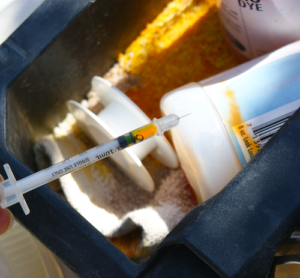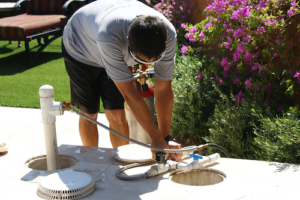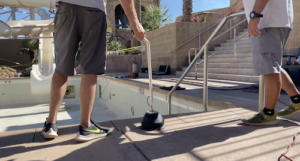Finding Pool Leaks
Because pools can leak in different parts of your pool, there are different types of tests that can be conducted in order to locate them. Locating the exact location of the leak is crucial in order to properly repair it. Professionals should always be called to perform the various tests using high-quality equipment so that nothing is overlooked. When looking for leaks, it’s important to first find the general area of where it could be. Once that is determined, the testing can be focused on that area alone in order to pinpoint the exact location.
Bucket Test:
This is a basic test that confirms that you may have a pool leak. This test requires you to take an open container and set it in your pool on a step or ladder with rocks inside. The container should be partially underwater and partially above the water. You then should fill the container so that the water level inside matches the level in the pool. Give it 24 hours and then check to see if the water in the pool is lower than the water in the bucket. Certain factors such as wind and rain can alter the results so be sure to note the weather conditions.
Dye Test:

This test requires a syringe that is used to release small amounts of dye in the location where a leak may be present. To get the most accurate results, turn off the pump in order to keep the water still. Also be sure to conduct the test in clear weather conditions so wind doesn’t move the water as well. If a swimming pool leak is present you will see the dye get pulled out of the pool when released. This test is usually handy for for finding leaks in skimmers, steps, and lights. For professionals, scuba equipment can be used to dye test cracks in the floor or main drain.
Pressure testing:

First off, pressure testing can be dangerous and should always be done by a professional. To sum up this type of test, pressure testing is done by sealing the pipes at one end and pressurizing the other. A proper plumbing system should be capable of holding pressure when closed. If the pressure drops at all, a leak is present.
Hydrophone & Sonar Testing:

When a pool leaks from its structure, a specific ultrasonic sound is made as the water makes its way through the crack. If the leak is suspected in the plumbing, the tech will push pressure through the pipes in question which will create a noise once it gets to the leak. Professionals can use hydrophone and sonar technology to listen for these sounds and try to find where it becomes the loudest. The louder the noise is, the closer they are to the location of the leak.
Leak Detection Isn’t Easy
Unless it is a bucket test, we highly recommend hiring a professional pool leak detection company to perform these tests. These tests can be tricky and should be done by someone with full knowledge of how each piece of equipment works. Also be sure to hire a company that specifically focuses on pool leak detection who is fully licensed and insured. Fortunately, our techs at PinPoint have years of experience in finding pool leaks and are always ready to help answer any questions you may have. And remember, if you suspect you possibly have a pool leak, get help right away. The longer you put it off, the more damage and costs you will have to deal with from the pool leak later.

